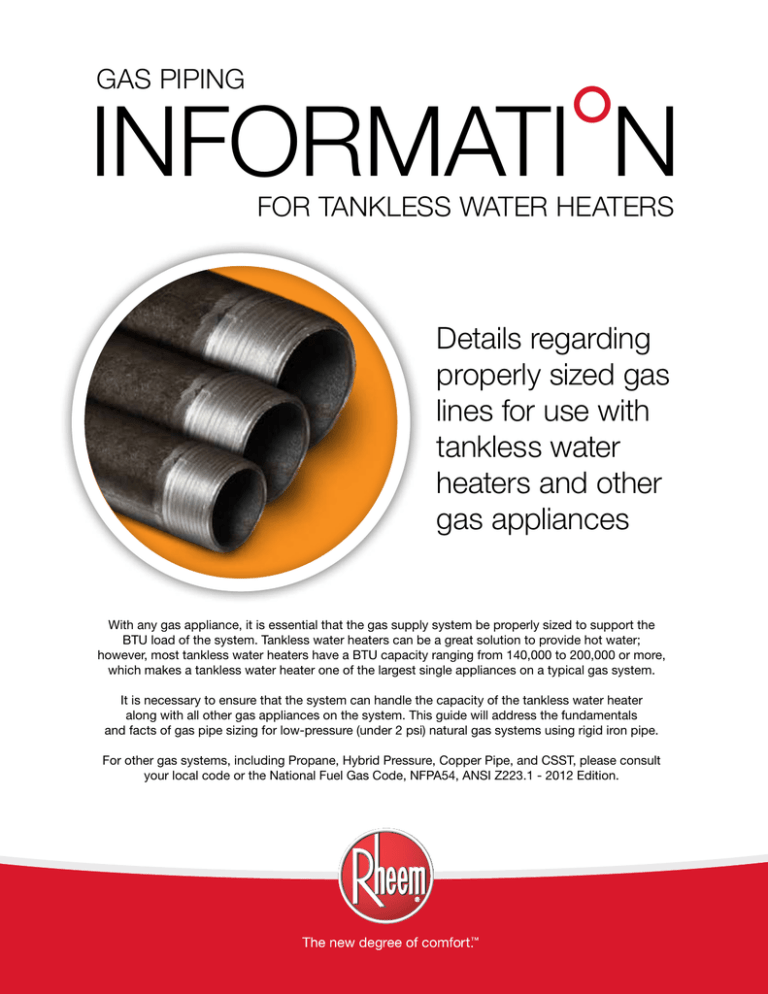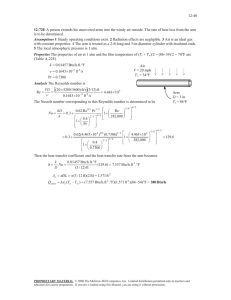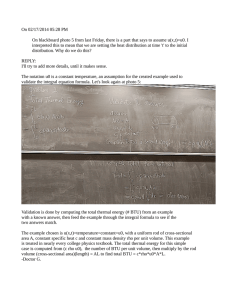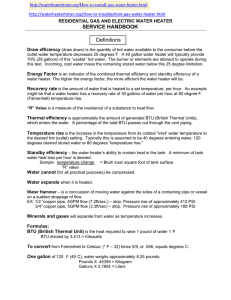Details regarding properly sized gas lines for use with
advertisement

GAS PIPING INFORMATION FOR TANKLESS WATER HEATERS Details regarding properly sized gas lines for use with tankless water heaters and other gas appliances With any gas appliance, it is essential that the gas supply system be properly sized to support the BTU load of the system. Tankless water heaters can be a great solution to provide hot water; however, most tankless water heaters have a BTU capacity ranging from 140,000 to 200,000 or more, which makes a tankless water heater one of the largest single appliances on a typical gas system. It is necessary to ensure that the system can handle the capacity of the tankless water heater along with all other gas appliances on the system. This guide will address the fundamentals and facts of gas pipe sizing for low-pressure (under 2 psi) natural gas systems using rigid iron pipe. For other gas systems, including Propane, Hybrid Pressure, Copper Pipe, and CSST, please consult your local code or the National Fuel Gas Code, NFPA54, ANSI Z223.1 - 2012 Edition. Gas Pipe System Facts Will a tankless water heater work on a ½-inch gas line? Yes and No. A typical residential gas system is a low-pressure system, meaning that the home is supplied with a gas pressure around 7 in. w.c. (inches of water column). The piping must be sized sufficiently enough so that the pressure drop is a half an inch of water column or less, when all the gas appliances are on. This can be the limiting factor when trying to use the existing piping and upgrading from a typical tank-type water heater to a tankless water heater. Typically, the gas piping has to be upgraded to support the tankless water heater due to the volume of fuel that is required. Tables 2 and 3 provide the capacity by pipe size and length based on the maximum allowable pressure drops. In all cases, a near 200,000 BTU gas appliance will require a minimum of a ¾-inch gas supply line. In specific conditions a ½-inch gas line may be used. In the 2012 National Fuel Gas Code (NFPA54. ANSI Z223.1), a 3.0 in. w.c. pressure drop chart was added for certain conditions. This chart allows a 200,000 BTU gas appliance to be installed on a ½-inch gas line up to 40 ft. in length. However, the following conditions must be met: The minimum static gas pressure must be 8 in. w.c. or greater; The calculated dropped pressure (the static pressure minus the 3.0 in. pressure drop), must be greater than the highest minimum gas pressure required by any of the gas appliances on the system. See Table 4 for pipes sizes and capacities with a 3 in. w.c. pressure drop. To select the correct diameter pipe, first determine the natural gas supply pressure for the system. The characteristics of the installation will specify the correct tables to use in ANSI Z223.1. Will an existing regulator and meter support a tankless water heater? Newer construction gas systems are typically a hybrid pressure system, where the incoming pressure is around 2 psi and each appliance or group of appliances are served by a single regulator. In many older areas and buildings, the system is supplied with a single, low-pressure gas system (around 7 in. w.c.) from the provider. In either case, the capacity of the regulator(s) and meter would need to be checked to ensure that the system can supply enough gas to support the addition of a tankless water heater to the system. On low-pressure systems, the pressure must be greater than the highest minimum requirement of the gas appliances plus the associated pressure drop. What size gas line will I need for my tankless water heater? The gas line size will depend on BTU rating of the water heater, the other gas appliances, and where they are installed on each branch from the meter and regulator. There are two methods for determining the required pipe size: the longest length method or the branch length method. See “Gas Pipe System Sizing” for more information. How do I tell what size regulator or meter I have? Each meter has a capacity in Cubic Feet per Hour (CFH). Locate that number regulator and multiply it by 1,024 (BTUH/CFH) to give you an approximate BTUH capacity for natural gas. The capacity of the meter and regulator must be greater than the total sum of the maximum BTU rating of all the appliances in the home. If the capacity of the system is too small, the gas appliances will not receive the volume of gas required for proper operation. What do all these different gas pressures mean? Gas pressure can be measured in two ways: pounds per square inch (psi) or Inches of Water Column (in. w.c.). The high-pressure side of hybrid pressure gas systems commonly measured in pounds per square inch. This pressure is around 2 psi. Inches of Water Column is typically used to measure low-pressure gas systems, which is what feeds most appliances. For example, there are 27.7 in. w.c. in 1 psi. What is Inches of Water Column? Inches of water column is a measurement of how much force it takes to push a column of water up by a number of inches. It is typically used to measure low-pressure gas systems. How do you measure the gas pressure? You will need an instrument called a Manometer. This tool allows you to measure the pressure of gas in the system. Manometers are available that measures a specific range of pressure in inches of water column or pounds per square inch. A digital Manometer can measure a broader range of pressures. See the manufacturer’s instructions for using the Manometer properly. Where do you find the BTU rating on my appliances? Each appliance is required to have a rating plate. This plate will list the BTU ratings of the appliance and required gas pressures for proper operation. See the manufacturer’s instructions for information on locating the rating plate on each gas appliance. Can a negative pressure gas valve solve an undersized gas system? While a negative pressure gas valve in an appliance can operate at a very low gas pressure, it can have adverse effects on an undersized gas system. This style of appliance can actually rob the gas from other appliances, such as a furnace and possibly cause nuisance outages. The piping and system must be sized to pass the volume of gas, not just the pressure. How would an undersized gas system affect the appliances? An undersized gas system can cause poor performance in the appliances. It could cause the burners to soot, pilots lights and burners to go out, or cause condensate to form in the heat exchanger of the furnace or water heater. Condensate will cause corrosion and eventual failure in appliances not specifically designed for it. Sooting can clog burners or flues which can cause an appliance to fail or produce harmful exhaust gases such as Carbon-Monoxide. Gas Pipe System Sizing Figure 1 - Typical Gas System with a Tankless Water Heater Gas Dryer (25,000 BTU) Furnace (75,000 BTU) Tankless Water Heater (199,900 BTU) G 15 ft E 20 ft C 15 ft J 20 ft D 30 ft Branch 1 Total 274,900 BTU A B 30 ft Branch 2 Total 120,000 BTU H 30 ft K 10 ft 20 ft Trunk Line Total 394,900 BTU Gas Logs Fireplace (40,000 BTU) Gas Range (55,000 BTU) Gas Meter (395 Cubic Feet) Determining the Required Meter and Regulator size. Find the BTU requirement of each appliance in the home. In our example above, we have the following: 199,900 BTU Tankless, a 75,000 BTU Furnace, a 55,000 BTU Range, a 25,000 BTU Dryer, and a 40,000 BTU Gas Log Fireplace. The sum of these appliances is 394,900 BTU. Since most gas regulators and meters are rated in Cubic Feet per Hour, we need to convert the BTU calculation to ensure they are sized correctly. Divide total BTU by 1,024 to get the estimated Cubic Feet per Hour (CFH) requirement for the meter and regulator; 386 CFH in our example. If the water heater was a typical tank type at 40,000 BTU, then the overall system requirement would have been just 235,000 BTU with a meter and regulator rated at 235 Cubic Feet per Hour. A typical household meter and regulator is commonly rated at 250 Cubic Feet per Hour. As you can see that in the example above, when you change the water heater to a tankless, the existing regulator and meter would be potentially undersized. It is important to have a properly sized meter and regulator on the system; otherwise, the appliances on the system could experience operational issues. The local gas utility can provide more information on upgrading the meter and regulator for the home. Hybrid pressure systems, with a 2 psi static pressure with regulators at each appliance, are sized differently than in this example. Consult your local gas supplier or the National Fuel Gas Code in regards to these type systems. Pipe Sizing Methods There are two basic pipe sizing methods: longest length and branch length. Proper sizing will allow the system to maintain the required minimum pressure drop. In the longest length method, the pipe size of each section should be determined by using the longest length of piping from the point of delivery, the gas meter or regulator, to the most remote outlet and the load of the section. In the branch length method, the pipe size of each section of the longest pipe run, from the point of delivery to the most remote outlet, should be determined by the longest run of piping and the load of the section. The pipe size of each section of branch piping should be determined using the length of piping from the point of delivery to the most remote outlet in each branch and the load of the section. Branch length sizing is the most common method. The information in this brochure is for educational purposes only, it is not meant to be an engineering guide or supplement any national or local code. All national and local codes muse be followed. The information in this brochure was obtained from the National Fuel Gas Code, NFPA54, ANSI Z223.1 2012 Edition. Refer to the National Fuel Gas Code, your local gas supplier, or your local code official for information. Gas systems should be designed, installed, and inspected by a certified and licensed gas fitter, engineer, or tradesman. The information in this guide does not apply for installations in Canada, see CAN/CSA B149.1 for details or consult with your local code official. Gas Pipe System Sizing Table 1 - Gas System Branch Sizing Example based on Figure 1 Line Segment Branch 1 Branch 2 Main Trunk Appliance BTU Required Line Length E Tankless Water Heater 199,900 G Gas Furnace D Minimum Pipe Size Required 0.3 w.c. drop 3.0 w.c. drop 20 ft 1” ½” 75,000 15 ft ½” ½” Branch Main Line 274.900 30 ft 1” ¾” J Gas Dryer 25,000 20 ft ½” ½” H Gas Range 55,000 30 ft ½” ½” K Gas Logs 40,000 10 ft ½” ½” B+C Branch Main Line 120,000 45 ft ¾” ½” A Main Trunk Line 394,900 20 ft 1 ¼” ¾” Determining Pipe Size by Length and Capacity We will need to calculate the total load of the system and each branch. In our sample system, Figure 1, measure and add the lengths of pipes at each section. Total the BTU of the appliances for each branch line and the main trunk line back to the gas meter. Select the appropriate sized gas line based on length, BTU capacity, and pressure drop from Table 2, Table 3, or Table 4. You can see that, in a typical gas system, a tankless water heater with a capacity of 199,900 BTU will require a 1-inch pipe size for a 20 ft branch length (based on the 0.3 in w.c. pressure drop in Table 2). The same appliance would require just a ½” pipe size based on Table 4 the 3.0 in w.c. pressure drop. A branch line is a pipe off the main line that feeds a group of appliances. In our example, we have two branch lines. The pipe size of the main pipe on the branch must be sized based on the total BTU of all the appliances on that branch line and pipe length. The trunk line pipe is the main pipe from the meter/regulator that feeds the different branches. The trunk line must be sized based on the total BTU from each branch-line system or the sum of the total BTU of all the appliances on the system and pipe length. Items such as elbows, tees, and valves are not included in these sample calculations. Their equivalent pipe length should be included when sizing gas systems. It is recommend that a licensed gas tradesman size, design, and install the gas system. Pipe Sizing Formula and Factors You can calculate the required inside diameter of the piping required for a specific appliance/system capacity and length. This formula is from the National Fuel Gas Code (NFPA 54, ANSI Z223.1, Section 6.4.1). Calculate Q by dividing the BTU capacity of the appliance(s) by 1,024. D= 19.17 ( Q 0.381 ΔH Cr x L ) 0.206 D = inside diameter of pipe (in.) Q = input rate of appliance (s) (cubic feet) (divide the BTU by 1,000 to get the cubic feet) To determine the allowable pressure drop, find the system static input gas pressure using a Manometer. Then, find the highest minimum gas pressure from all the appliances, usually listed on the appliances rating label. Subtract the highest minimum gas pressure from the static input gas pressure to get the difference. For example, the input static pressure is 7 in. w.c.; the highest minimum pressure is 6 in. w.c.; leaving a difference of 1 in. w.c. In this example the system can have a .5 in. w.c. pressure drop based on Table 3. If the input pressure was 9 in. w.c., in this example, then a 3.0 in. w.c. pressure drop based on Table 4 would be allowable. For additional sizing information for Hybrid Pressure Systems, Propane Gas Systems, and Corrugated Stainless Steel Tubing, see the 2012 Edition of the ΔH= pressure drop [in. w.c.] National Fuel Gas Code, NFPA 54, ANSI Z223.1, or consult with your local gas L = equivalent length of pipe utility or code officials. Cr= gas formula factor 0.6094 for Natural Gas Rheem.com Gas Pipe Capacity Charts Table 2 - 0.3 Inch Water Column Pressure Drop for Black Iron - Schedule 40 Metallic Pipe Pipe Size (in.) Nominal Dia. ½ ¾ 134,144 92,160 73,728 63,488 56,320 51,200 47,104 43,008 40,960 38,912 279,552 192,512 154,624 132,096 116,736 106,496 97,280 91,136 84,992 80,896 Length (ft) 10 20 30 40 50 60 70 80 90 100 1 1¼ Capacity in BTU per Hour** 526,336 1,085,440 363,520 743,424 290,816 596,992 248,832 510,976 220,160 452,608 199,680 409,600 183,296 376,832 171,008 351,232 160,768 329,728 151,552 311,296 1½ 2 1,617,920 1,116,160 893,952 764,928 677,888 614,400 565,248 526,336 493,568 465,920 3,123,200 2,140,160 1,720,320 1,474,560 1,310,720 1,187,840 1,085,440 1,012,736 950,272 898,048 ** Calculated based ANSI Z223.1-2012 Table 6.2(a) using 1,024 BTU per Cubic Foot of Gas Table 3 - 0.5 Inch Water Column Pressure Drop for Black Iron - Schedule 40 Metallic Pipe Pipe Size (in.) Nominal Dia. ½ ¾ Length (ft) 10 20 30 40 50 60 70 80 90 100 176,128 120,832 97,280 82,944 73,728 66,560 61,440 57,344 53,248 51,200 368,640 252,928 203,776 174,080 154,624 140,288 129,024 119,808 112,640 106,496 1 1¼ Capacity in BTU per Hour** 694,272 1,423,360 477,184 979,968 382,976 786,432 327,680 672,768 290,816 596,992 263,168 540,672 242,688 497,664 225,280 462,848 211,968 434,176 199,680 409,600 1½ 2 2,140,160 1,464,320 1,177,600 1,008,640 893,952 809,984 745,472 693,248 650,240 614,400 4,116,480 2,826,240 2,273,280 1,945,600 1,720,320 1,556,480 1,433,600 1,331,200 1,249,280 1,187,840 ** Calculated based ANSI Z223.1-2012 Table 6.2(b) using 1,024 BTU per Cubic Foot of Gas Table 4 - 3 Inch Water Column Pressure Drop for Black Iron - Schedule 40 Metallic Pipe Initial gas supply pressure must be 8.0 inches of water column or greater Pipe Size (in.) Nominal Dia. ½ ¾ Length (ft) 10 20 30 40 50 60 70 80 90 100 464,896 319,488 256,000 219,136 194,560 176,128 161,792 150,528 141,312 134,144 971,776 667,648 536,576 458,752 396,288 368,640 338,944 315,392 295,936 279,552 1 1¼ Capacity in BTU per Hour** 1,829,888 3,757,056 1,257,472 2,582,528 1,009,664 2,073,600 864,256 1,774,592 765,952 1,572,864 694,272 1,425,408 638,976 1,310,720 593,920 1,219,584 557,056 1,144,832 526,336 1,081,344 1½ 2 5,628,928 3,868,672 3,868,672 2,659,328 2,357,248 2,135,040 1,965,056 1,827,840 1,715,200 1,619,968 10,842,112 7,451,648 5,984,256 5,121,024 4,539,392 4,112,384 3,783,680 3,519,488 3,302,400 3,119,104 ** Calculated based ANSI Z223.1-2012 Table 6.2(c) using 1,024 BTU per Cubic Foot of Gas Tables are based on the National Fuel Gas Code, NFPA54, ANSI Z223.1 2012 Edition. Rheem helps you give your customers the value, performance and features they want. From our tried and true tank-type water heaters to our space-saving tankless solutions that provide continuous hot water, Rheem has something to satisfy the budgets and lifestyles of every customer. In addition to our large selection of water heating solutions, Rheem also has a full line of heating and cooling products, parts and accessories for warm winter nights, cool summer days and hot water all year long. In keeping with its policy of continuous progress and improvement, Rheem reserves the right to make changes without notice. The information in this brochure is for educational purposes only, it is not meant to be an engineering guide or supplement any national or local code. All national and local codes muse be followed. The information in this brochure was obtained from the National Fuel Gas Code, NFPA54, ANSI Z223.1 2012 Edition. Refer to the National Fuel Gas Code or your local gas supplier or code official for information. Gas systems should be designed, installed, and inspected by a certified and licensed gas fitter, engineer, or tradesman. The information in this guide does not apply for installations in Canada, see CAN/CSA B149.1 for details or consult with your local code official. Rheem Water Heating • 101 Bell Road Montgomery, AL 36117 • 1.800.621.5622 • www.rheem.com Rheem.com PRINTED IN U.S.A. 09/16 TK-GPF-12 Rev 1


